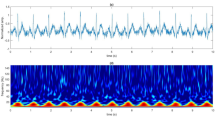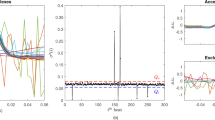Abstract
The measurement of ensemble variability in time-aligned event signals is studied in relation to sampling rate requirements. The theoretical analysis is based on statistical modelling of time misalignment in which the time resolution is limited by the length of the sampling interval. For different signal-to-noise ratios (SNRs), the sampling rate is derived which limits the misalignment effect to less than 10% of the noise effect. Each signal is assumed to be corrupted by additive noise. Using a normal QRS complex with a high SNR (≈ 30 dB), a sampling rate of approximately 3 kHz is needed for accurate ensemble variability measurements. This result is surprising since it implies that the Nyquist rate is far too low for accurate variability measurements. The theoretical results are supplemented with results obtained from an ECG database of 94 subjects for which the ensemble variability is computed at different sampling rates using signal interpolation. The ensemble variability is substantially reduced (40%) when increasing the rate from 1 to 3 kHz, thus corroborating the results suggested by the theoretical analysis.
Similar content being viewed by others
References
Barbaro, V., Bartolini, P., andFierli, M. (1991): ‘New algorithm for the detection of ECG fiducial point in the averaging technique’,Med. Biol. Eng. Comput.,29, pp. 129–135
Barr, R., andSpach, M. (1977): ‘Sampling rate required for digital recordings of intracellular and extracellular cardiac potentials’,Circulation,55, pp. 40–49
Ben-Haim, S., Gil, A., andEdoute, Y. (1992): ‘Beat to beat morphology variability of the electrocardiogram for the evaluation of the chest pain in the emergency room’,Am. J. Cardiol.,70, pp. 1139–1142
Berson, A. (1976): ‘Bandwidth sampling, and quantising for automated ECG processing’, in, ‘Computers in cardiology’ (IEEE, Piscataway, NJ), pp. 295–301
Blanchard, S., andBarr, S. (1985): ‘Comparison of methods for adaptive sampling of cardiac electrograms and electrocardiograms’,Med. Biol. Eng. Comput.,23, pp. 377–386
Breithardt, G., Cain, M. E., El-Sherif, N., Flowers, N., Hombach, V., Janse, M., Simson, M., andSteinbeck, G. (1991): Standards for analysis of ventricular late potentials using high resolution or signal-averaged electrocardiography’,J. Am. Coll. Cardiol.,17, pp. 999–1006
Gevins, A. S., andRémond, A. (1987): ‘Handbook of electroencephalography and clinical neurophysiology: methods of analysis of brain electrical and magnetic signals’, volume 1 (Elsevier)
Jané, R., Rix, H., Caminal, P., andLaguna, P. (1991): ‘Alignment methods for signal averaging of high resolution cardiac signals: a comparative study of performance’,IEEE Trans. Biomed. Eng.,38, (6), pp. 571–579
Laguna, P., Jané, R., andCaminal, P. (1994): ‘A time delay estimator based on the signal integral: Theoretical performance and testing on ECG signals’,IEEE Trans. Signal Process. 42, (11), pp. 3224–3229
Laguna, P., Simon, B., andSörnmo, L. (1997): ‘Improvement in high-resolution ECG analysis by interpolation before time alignment’, in ‘Computers in cardiology’ (IEEE, Piscataway, NJ), pp. 617–620
Nowak, J., Hagerman, I., Ylén, M., Nyquist, O., andSylvén, C. (1993): ‘Electrocardiogram signal variance analysis in the diagnosis of coronary artery disease-a comparison with exercise stress test in an angiographically documented high prevalence population’,Clin. Cardiol.,16, pp. 671–682
Prasad, K., andGupta, M. (1979): ‘Phase-variant signature algorithm. A noninvasive technique for early detection and quantification of Ouabain-induced cardiac disorders’, Angiology,30, pp. 721–732
Rompelman, O., andRos, H. H. (1986): ‘Coherent averaging technique: a tutorial review. Part 1: Noise reduction and the equivalent filter. Part 2: Trigger jitter, overlapping responses and non-periodic stimulation’,J. Biomed. Eng.,8, pp. 24–35
Shaw, G. R., andSavard, P. (1995): ‘On the detection of QRS variations in the ECG’,IEEE Trans. Biomed. Eng.,42, pp. 736–741
Sörnmo, L. (1998): ‘Vectorcardiographic loop alignment and morphologic beat-to-beat variability’,IEEE Trans. Biomed. Eng.,45, pp. 1401–1413
Sörnmo, L., Wohfart, B., Berg, J., andPahlm, O. (1998): ‘Beat-to-beat QRS variability in the 12-lead ECG and the detection of coronary artery disease’,J. Electrocardiol.,31, pp. 336–344
Uijen, G. J., De Weerd, J. P., andVendrik, A. J. (1979): ‘Accuracy of QRS detection in relation to the analysis of high-frequency components in the electrocardiogram’,Med. Biol. Eng. Comput.,17, pp. 492–502
Van Trees, H. (1968): ‘Detection, estimation and modulation theory, part I‘ (John Wiley & Sons, New York)
Woody, C. (1967): ‘Characterization of an adaptive filter for the analysis of variable latency neuroelectric signals’,Med. Biol. Eng.,5, pp. 539–553
Yamamoto, H., Miyahara, H., andDomae, A. (1987): ‘Is a higher sampling rate desirable in the computer processing of the pediatric electrocardiogram?’,J. Electrocardiol.,20, pp. 321–328
Zywietz, C., Spitzenberger, U., Palm, C., andWetjen, A. (1983): ‘A new approach to determine the sampling rate of ECGs’, in ‘Computers in cardiology’, (IEEE, Piscataway, NJ), pp. 261–264
Author information
Authors and Affiliations
Corresponding author
Rights and permissions
About this article
Cite this article
Laguna, P., Sörnmo, L. Sampling rate and the estimation of ensemble variability for repetitive signals. Med. Biol. Eng. Comput. 38, 540–546 (2000). https://doi.org/10.1007/BF02345750
Received:
Issue Date:
DOI: https://doi.org/10.1007/BF02345750




